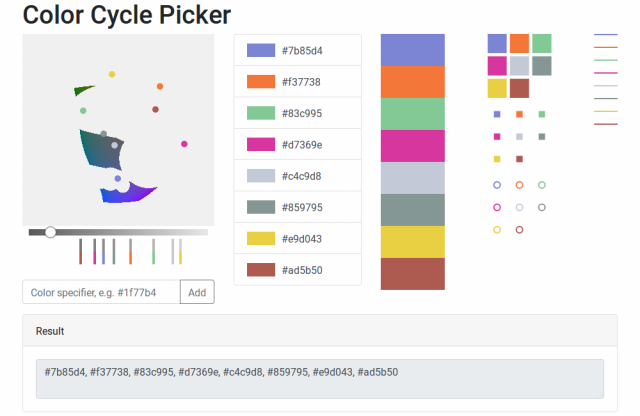The “category10” color palette, originally developed by Tableau, was adopted as the default color cycle for Matplotlib 2.0 and is also used by default by D3.js and Vega, along with other software packages. While more aesthetically pleasing than the old Matplotlib default, it is unfortunately not colorblind-friendly.1 In an effort to improve this and promote the development of colorblind-friendly color cycles for scientific visualization, I built a color cycle picker that incorporates color vision deficiency simulation and enforces a minimum perceptual distance between colors, for both normal and anomalous trichromats. This is accomplished by performing color vision deficiency simulations2 for various types of deficiencies and enforcing a minimum perceptual difference for the simulated colors using the CAM02-UCS3 perceptually uniform color space (each type of deficiency is treated separately). Additionally, a minimum lightness distance is enforced, for better grayscale printability. The tool allows colors to be picked from a visualization of the CAM02-UCS color gamut and assembled into a color cycle. This visualization is performed using hardware-accelerated WebGL to allow for real-time interactive adjustment of parameters; the resulting palette is also visualized. The minimum perceptual color distance, lightness distance, and color vision deficiency simulation parameters are all adjustable. A hosted copy is provided, and the code is available in a repository on GitHub.
Personally, I have difficulty telling the second and third colors apart. ↩
G. M. Machado, M. M. Oliveira and L. A. F. Fernandes, “A Physiologically-based Model for Simulation of Color Vision Deficiency,” in IEEE Transactions on Visualization and Computer Graphics, vol. 15, no. 6, pp. 1291-1298, Nov.-Dec. 2009. doi:10.1109/TVCG.2009.113 ↩
Luo M.R., Li C. (2013) CIECAM02 and Its Recent Developments. In: Fernandez-Maloigne C. (eds) Advanced Color Image Processing and Analysis. Springer, New York, NY. doi:10.1007/978-1-4419-6190-7_2 ↩
